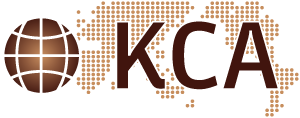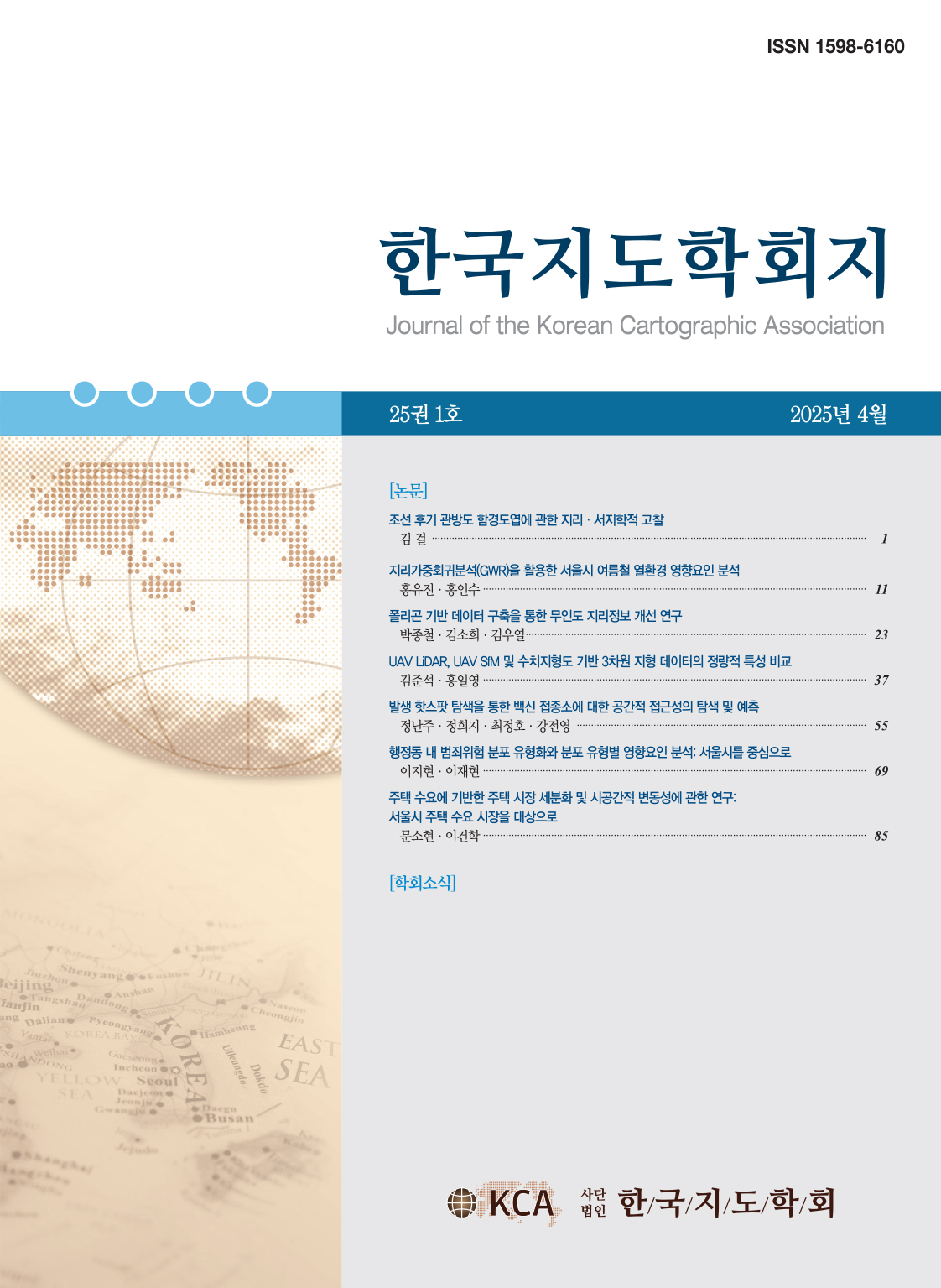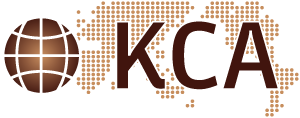Research Article
Abstract
References
Information
After industrialization in the 1960s, Korean society experienced rapid modernization and compressed growth in a wide range of areas such as economy and politics for a short period of time. However, in this trend, the income gap and polarization between classes may deepen, causing spatial inequality. This study confirmed the relationship between income level and infrastructure accessibility in order to confirm the possibility of spatial inequality in the income class. Using big data, the relationship between income level and infrastructure accessibility was quantitatively analyzed using income level data and infrastructure data including accurate location. The spatial scope was set to Seoul City, and the temporal scope was set to 2017. The analysis used variables affecting infrastructure accessibility, including income level, population density, population, CBD, and detailed facility classification variables, and infrastructure facilities were largely classified into education, transportation, culture/leisure, health, and sports facilities. As a result, it was confirmed that there was a difference in infrastructure accessibility according to income level, and a high correlation was derived in all infrastructure areas except transportation infrastructure, confirming that a significant relationship existed between income level and infrastructure accessibility. In addition, the infrastructure sector that responds most sensitively to changes in income level and the difference in infrastructure accessibility according to income level were identified.
우리 사회는 1960년대 산업화 이후 경제, 정치 등 다양한 영역에서 급속한 근대화와 압축 성장을 이루었다. 하지만 이러한 성장 속에서 계층 간 소득 격차와 양극화가 심화되는 등 여러 문제가 발생했고, 이는 국토 전체적으로는 물론 도시 내에서도 지역 간 불균형 발전을 야기했다. 본 연구는 소득 수준이 지역 간 불균형 발전에 미치는 영향을 확인하기 위해 가구별 연평균 소득과 인프라 접근성 간 관계를 실증적으로 분석한다. 연구에서는 서울시 소득 수준 데이터와 인프라 데이터를 사용하여 소득 수준과 인프라 접근성 간 관계를 다중회귀분석을 사용해 분석하였다. 연구의 공간적 범위는 서울시이며, 시간적 범위는 2017년으로 설정했다. 인프라 시설은 교육, 교통, 문화・여가, 보건, 체육 관련 시설로 구분했으며, 소득 수준과 함께 인구 밀도, 인구 수, 중심업무지구 여부 등이 접근성에 미치는 영향을 분석했다. 분석 결과 소득 수준에 따라 인프라 접근성에 차이가 나타난 것을 확인했고, 교통 인프라를 제외한 모든 분야에서 비교적 높은 상관관계가 도출되었다. 또한, 소득 수준 변화에 민감하게 반응하는 분야와 소득 수준에 따라 나타나는 인프라 접근성의 차이를 확인할 수 있었다.
- 강성익・구자훈, 2020, “지역 불평등과 사회적 자본의 분포특성 및 상관관계 분석 - 서울시 권역생활권 및 자치구를 중심으로 -,” 서울도시연구, 21(4), 223-238.
- 강신욱・김안나・박능후・김은희・유진영, 2005, 「사회적 배제의 지표개발 및 적용방안 연구」, 한국보건사회연구원.
- 구인회, 2005, “빈곤의 동태적 분석: 빈곤지속기간과 그 결정요인,” 한국사회복지학, 57(2), 351-374.
- 김가희, 2017, “공간회귀분석을 이용한 지역사회서비스 투자사업 공간접근성 영향요인 분석,” 사회복지정책, 44(2), 145-178. 10.15855/swp.2017.44.2.145
- 김규식, 2016, “공공보육서비스 이용 기회의 공간적 형평성 평가 - 2009년과 2014년의 서울시 국공립어린이집을 대상으로 -,” 서울도시연구, 17(1), 45-64.
- 김도영, 2012, “소득수준별 보건의료서비스 이용 형평성 변화 분석,” 사회과학연구, 23(3), 105-125.
- 김동진, 2015, “우리나라 의료이용 및 건강수준 불평등,” 보건・복지 Issue&Focus, 280, 1-8. 10.23064/2015.05.280
- 김민성・박세운, 2014, “지하철 접근성이 아파트가격에 미치는 영향에 관한 연구,” 한국경영학회 2014년 통합학술발표논문집, 2912-2931.
- 김아연・전병운, 2012, “대구시 대중교통서비스의 접근성에 대한 환경적 형평성 분석,” 한국지리정보학회지, 15(1), 76-86. 10.11108/kagis.2012.15.1.076
- 김영선, 2012, “노인의 건강 및 의료이용 형평성에 관한 연구: 연령집단별 분석,” 보건과 사회과학, 31, 55-81.
- 김영종, 2010, “한국 사회복지행정학의 역사적 평가와 과제,” 한국사회복지행정학, 12(1), 177-203. 10.34225/jidc.2010.3.177
- 김종근, 2023, “임신・출산 인프라 접근성 취약지역 분석,” 한국지도학회지, 23(1), 53-65. 10.16879/jkca.2023.23.1.053
- 김찬성・황상규・성홍모, 2007, “국가균형발전을 위한 교통접근성 제고방안 - 형평석 분석을 중심으로,” 교통 기술과 정책, 4(2), 48-59.
- 남궁옥, 2020, “생활SOC 접근성의 차이에 따른 삶의 질 형평성 연구 - 세종특별자치시를 사례로 -,” 환경논총, 65, 114-116.
- 박세경・이정은・신수민・양난주, 2013, 「사회서비스 수요공급의 지역단위 분석 연구」, 한국보건사회연구원.
- 박정환・우현지・김영훈, 2017, “수정 3SFCA 모형을 활용한 응급의료서비스 접근성 분석: 충청남도를 사례로,” 한국지역지리학회지, 23(2), 388-402. 10.26863/JKARG.2017.05.23.2.388
- 박혜현・이건학, 2021, “공간적 효율성과 형평성을 고려한 도시공원 입지의 방문 잠재력 평가: 서울시 도시자연공원구역을 사례로,” 한국지도학회지, 21(1), 75-88. 10.16879/jkca.2021.21.1.075
- 빈미영・이원도・문주백・조창현, 2013, “교통인프라와 통행행태를 기반으로 한 통합적 형평성 분석 : 경기도를 중심으로,” 대한교통학회지, 31(4), 47-57. 10.7470/jkst.2013.31.4.047
- 신동면, 2006, “경제위기 이후 한국 사회의 소득 양극화 실태와 사회보장의 과제,” 사회이론, 29, 34-62.
- 신호성, 2009, “건강수준 및 의료이용의 형평성과 정책과제,” 보건복지포럼, 149, 26-35.
- 안영웅・임윤택・이상호, 2020, “대전시 소방서비스의 공간적 형평성,” 한국콘텐츠학회논문지, 20(3), 560-571. 10.5392/JKCA.2020.20.03.560
- 엄선희・문춘걸, 2010, “소득계층에 따른 보건의료의 형평성: 『한국노동패널』 자료를 중심으로,” 보건경제와 정책연구, 16(1), 35-61.
- 여지영・정현선, 2012, “구강검진 및 필요치과진료 수진의 결정요인: 경제적 접근성과 지리적 접근성 간의 상호작용효과 분석,” 보건경제와 정책연구, 18(4), 109-126.
- 윤태호, 2010, “지역 간 건강 불평등의 현황과 정책과제,” 상황과 복지, 30, 49-77.
- 이미숙, 2005, “한국 성인의 건강불평등: 사회계층과 지역 차이를 중심으로,” 한국사회학, 39(6), 183-209.
- 이병희・정재호, 2002, “경제위기 이후의 빈곤구조 분석 - 반복빈곤 및 고용과의 관계를 중심으로,” 동향과 전망, 52, 128-150.
- 이상일, 2012, “공간적 상호작용론의 본질과 연구 영역: 인문지리학에 대한 통섭적 접근,” 한국지리학회지, 1(1), 137-151. 10.25202/JAKG.1.1.11
- 이용재, 2010, “소득계층별 건강상태에 따른 의료이용 형평성 분석,” 한국사회정책, 17(1), 267-290. 10.17000/kspr.17.1.201004.267
- 이정원・임미화・김학열, 2020, “접근성 기반의 유치원 입지 및 수요 분석: 전라북도 전주시를 대상으로,” 도시정책연구, 11(2), 59-78. 10.21447/jup.2020.11.2.59
- 이지원・유기윤・김지영, 2019, “SNS 데이터를 이용한 공공시설 매력도지수에 따른 접근성 분석기법,” 한국측량학회지, 37(1), 29-42. 10.7848/ksgpc.2019.37.1.29
- 임국환・이준협, 2010, “의료기관 종별 소득계층간 의료이용 불평등,” 보건경제와 정책연구, 16(2), 39-56.
- 임미영・유호신, 2001, “전국 저소득층노인의 보건의료이용과 영향요인 분석,” 지역사회간호학회지, 12(3), 589-599.
- 임윤택・서창우・이상호, 2012, “도시계획사업이 공간적 형평성에 미치는 효과 - GIS를 이용한 대전광역시 도로건설사업의 소득계층간 접근성 변화 분석 -,” 한국지리정보학회지, 15(2), 23-34. 10.11108/kagis.2012.15.2.023
- 전보애, 2014, “지역규모에서 공공도서관의 공간접근성 분석: 강원도를 사례로,” 한국지도학회지, 14(1), 93-105.
- 정재훈・김경민, 2014, “교육의 공간 불평등 연구,” 2014년 대한지리학회 지리학대회 발표초록집, 375-375.
- 조대헌・신정엽・김감영・이건학, 2010, “농촌지역 공공 보건서비스에 대한 공간적 접근성 분석,” 한국지역지리학회지, 16(2), 137-153.
- 채정표・성현곤, 2019, “도로 네트워크와 통행량 기반의 공간접근성 지수가 주택가격에 미치는 영향,” 국토계획, 54(2), 76-83. 10.17208/jkpa.2019.04.54.2.76
- Alcock, P, 1997, Understanding Poverty, 2nd ed., London: Macmillan. 10.1007/978-1-349-25666-2
- Dalvi, M.Q. and Martin, K.M., 1976, The measurement of accessibility: Some preliminary results, Transportation, 5(1), 17–42. 10.1007/BF00165245
- Ester, M., Kriegel, H.-P., Sander, J., and Xu, X., 1996, A density-based algorithm for discovering clusters in large spatial databases with noise, Proceedings, Second International Conference on Knowledge Discovery and Data Mining, August 2-4, Portland, Oregon, 226–231.
- Gates, B.L., 1980, Social program administration: The implementation of social policy, New Jersey: Prentice-Hall.
- Gregory, D., Johnston, R., Pratt, G., Watts, M., and Whatmore, S., 2011, The Dictionary of Human Geography, 5th ed., New York: John Wiley & Sons.
- Harris, B., 2001, Accessibility: Concepts and applications, Journal of Transportation and Statistics, 4(2/3), 15-30.
- Hunter, J.M., Shannon, G.W., and Sambrook, S.L., 1986, Rings of madness: Service areas of 19th century asylums in North America, Social Science & Medicine, 23(10), 1033-1050. 1033-1050. 10.1016/0277-9536(86)90262-53547682
- Kerbo, H.R., 2003, Social Stratification and Inequality: Class Conflict in Historical and Global Perspective, 5th ed., Boston: McGraw-Hill.
- Koenig, J.G., 1980, Indicators of urban accessibility: Theory and application, Transportation, 9(2), 145-172. 10.1007/BF00167128
- Litchfield, J.A., 1999, Inequality: Methods and tools, World Bank.
- Radke, J. and Mu, L., 2000, Spatial decompositions, modeling and mapping service regions to predict access to social programs, Geographic Information Sciences, 6(2), 105-112. 10.1080/10824000009480538
- Shi, Z. and Pun-Cheng, L.S.C., 2019, Spatiotemporal data clustering: A survey of methods, ISPRS International Journal of Geo-Information, 8(3), 112-128. 10.3390/ijgi8030112
- Wan, N., Zou, B., and Sternberg, T., 2012, A three-step floating catchment area method for analyzing spatial access to health services, International Journal of Geographical Information Science, 26(6), 1073-1089. 10.1080/13658816.2011.624987
- Publisher :The Korean Cartographic Association
- Publisher(Ko) :한국지도학회
- Journal Title :Journal of the Korean Cartographic Association
- Journal Title(Ko) :한국지도학회지
- Volume : 23
- No :3
- Pages :69-80
- DOI :https://doi.org/10.16879/jkca.2023.23.3.069



 Journal of the Korean Cartographic Association
Journal of the Korean Cartographic Association





